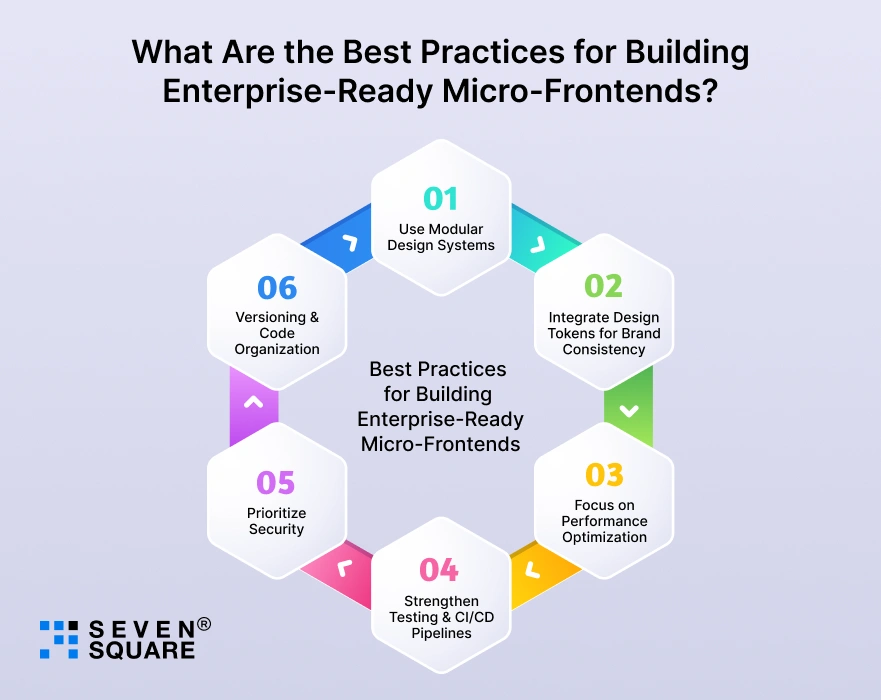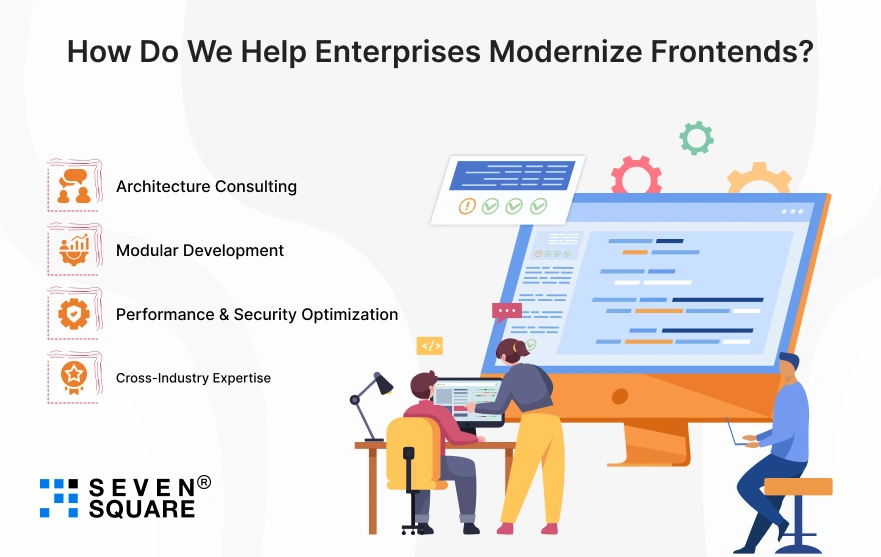Many enterprises still depend on monolithic frontends like massive codebases that make every update, feature release, or bug fix painfully slow.
As businesses expand and products evolve, maintaining a single, tightly coupled frontend becomes a real challenge.
Even the smallest change can affect the entire system, increasing risk, slowing deployment, and making innovation harder.
That’s where micro frontends feel like the next logical step in frontend evolution.
Just as microservices transformed the backend world, micro frontends are revolutionizing the frontend architecture.
They allow large enterprises to break down massive web apps into smaller, manageable, and independently deployable pieces to improve collaboration, performance, and release speed.
In this blog, you will learn about micro frontends best practices and micro-frontend architecture to determine why it is best for your enterprise.
What Are Micro-Frontends?
In simple words, micro-frontends show the idea of microservices to the user interface.
Instead of building one massive frontend application, developers divide it into smaller, self-contained modules, each owned by an independent team, with its own codebase, release cycle, and deployment pipeline.
Frontend modularization is the process of breaking down part of your web app (like the search bar, dashboard, or payment page) into an independent app that seamlessly integrates with others.
This micro-frontend architecture gives teams freedom to choose different frameworks (React, Angular, Vue, etc.) without affecting other modules.
It also allows continuous delivery since each part can be updated or deployed independently.
- Monolithic frontends: Tightly coupled and hard to scale.
- Microservices: Backend modularization.
- Micro-frontends: Modular UI for faster, flexible enterprise apps.
Real-world enterprises like Netflix, Amazon, and Spotify already use micro-frontend principles to improve performance, scalability, & user experience.
The Change From Monolithic to Micro-Frontend Architecture
The debate of micro frontends vs monolith has become one of the most important in frontend architecture evolution.
In a monolithic frontend, everything from layout to business logic is bundled together in one large codebase.
It works fine initially, but as your enterprise web app grows, the problems multiply:
- Code becomes harder to maintain.
- Teams step on each other’s toes during releases.
- A single bug can break the entire application.
- Deployment pipelines slow down significantly.
Micro-frontend architecture solves these problems by splitting large frontends into smaller, autonomous pieces.
Each piece, or “micro app,” can be developed, tested, and deployed independently by different teams.
- Faster development cycles.
- Easier scalability.
- Parallel team workflows without code conflicts.
- Independent deployments and rollbacks.
Learn more about Best Figma to Frontend Tools.
How Micro-Frontends Work?
Understanding how micro-frontends work is key to implementing them effectively.
Micro-frontends use integration frameworks and patterns that enable multiple apps to function as one unified experience. The most popular approaches include:
- Webpack Module Federation: This allows separate frontend apps to share components dynamically at runtime. It’s one of the most powerful tools for connecting micro frontends smoothly.
- Single-SPA Micro Frontends: A JavaScript framework that lets multiple frontend frameworks coexist on the same page without conflict.
- Web Components: Custom elements that encapsulate functionality and styling, ensuring reusability and consistency across apps.
Common micro frontend patterns used in enterprises include:
- Build-Time Integration: Combining apps during the build process.
- Run-Time Integration: Dynamically loading micro apps in the browser.
- Server Composition: Merging different frontends server-side before sending to users.
Whether you prefer Module Federation for React apps or Single-SPA for hybrid frontends.
Our focus is on building systems that integrate smoothly, scale effortlessly, and deliver consistent performance.
Why Enterprises Are Adopting Micro-Frontends?
Micro frontends in enterprise development are a core part of digital transformation.
Large organizations today face several common pain points:
- Long release cycles are slowing innovation.
- Dependency bottlenecks across teams.
- Complex CI/CD pipelines for massive applications.
- High risk of downtime during updates.
Micro-frontend architecture directly handles these issues. It breaks your frontend into modular parts so that your teams can work independently to improve agility.
- Faster time-to-market: Deploy new features without waiting on other teams.
- Improved performance: Load only what’s needed per page.
- Reduced risk: Isolated deployments prevent full app failures.
- Cost efficiency: Lower maintenance overhead and faster iterations.
Over 60% of enterprise web apps are expected to adopt micro-frontend architecture by 2026, driven by the need for flexible, scalable, and future-ready systems.
Micro frontends are a strategic advantage for enterprises that want to lead in innovation and speed.
Micro-Frontends Pros and Cons: What You Should Know?
Like any modern architecture, micro frontends come with both advantages and trade-offs.
We help enterprises weigh the pros and cons carefully before deciding to move away from monolithic systems.
Pros of Micro-Frontends
- Scalability: Easily scale different parts of your web app independently.
- Independent Teams: Each team can own and deploy its part without waiting for others.
- Faster Updates: Quick release cycles and continuous delivery become easier.
- Better UX Consistency: Consistent experience across devices through shared design systems.
- Improved Performance: Optimized micro frontends load faster and allow selective updates.
Cons of Micro-Frontends
- Integration Complexity: Bringing multiple frontends together smoothly takes effort.
- Shared State Issues: Managing data consistency between independent modules can be tricky.
- Increased DevOps Overhead: More pipelines and monitoring tools are needed.
- Learning Curve: Teams need time to adapt to new tools and architecture patterns.
Monolithic Frontend vs Micro-Frontend Architecture
| Aspect | Monolithic Frontend | Micro-Frontend Architecture |
|---|---|---|
| Scalability | Limited | Highly scalable across teams |
| Deployment | Single, risky release | Independent deployments |
| Performance | Can degrade over time | Optimized for performance |
| Team Collaboration | Centralized, slower | Decentralized, faster |
| Maintenance | Complex | Modular and easier |
What Are the Best Practices for Building Enterprise-Ready Micro-Frontends?

Building enterprise-ready micro frontends requires thoughtful planning and smart execution. Here’s what we recommend:
1. Use Modular Design Systems
- Create a shared UI library for buttons, icons, and components.
- This ensures UI consistency and simplifies updates across all micro frontends.
2. Integrate Design Tokens for Brand Consistency
- Use Design Tokens to manage colors, typography, and spacing globally.
- This keeps your brand identity unified, even when multiple teams work on separate modules.
3. Focus on Performance Optimization
- Monitor micro frontends performance by lazy-loading modules, caching assets, and using CDN delivery.
- Optimize only the parts needed per view for faster load times.
4. Strengthen Testing & CI/CD Pipelines
- Automate testing and deployment for every micro app.
- Use continuous integration tools to ensure quality across independent modules before they merge.
5. Prioritize Security
- Secure communication between micro frontends using token-based authentication and cross-domain policies.
- Follow role-based access and validation for every micro app.
6. Versioning & Code Organization
- Maintain separate repositories for each micro frontend, but keep a centralized registry for shared dependencies.
- This avoids version conflicts and simplifies updates.
We help enterprises set up robust CI/CD pipelines, modular design systems, and secure frontends that are built to scale and perform at the enterprise level.
How Do We Help Enterprises Modernize Frontends?

Our expertise in frontend modernization helps businesses move from slow, monolithic frontends to modular, scalable, and high-performing micro-frontend architectures.
- Architecture Consulting: We analyze your existing frontend and plan the right modernization path.
- Modular Development: We build reusable, independent micro apps that improve speed and collaboration.
- Performance & Security Optimization: We fine-tune your app for speed, security, and scalability.
- Cross-Industry Expertise: From eCommerce and SaaS to logistics & fintech, we’ve helped enterprises deliver faster and more reliable user experiences.
Want to Modernize Your Frontend Architecture? Contact Us Now!
How to Start with Micro-Frontends? Implementation Guide
If you’re wondering how to implement micro frontends in React or any other framework, here’s a practical guide so enterprises can modernize legacy frontends.
1. Assess Your Current Frontend
- Identify bottlenecks, shared dependencies, and potential modules that can be split (like dashboard, analytics, or payments).
2. Choose the Right Tech Stack
- React with Webpack Module Federation for flexible integration.
- Angular for enterprise-grade apps.
- Vue for lightweight frontends.
- Use Single-SPA if you need to combine multiple frameworks.
3. Plan a Step-by-Step Migration Strategy
- Start small, migrate one feature or page into a micro-frontend first.
- Gradually separate others while maintaining user experience.
- We help enterprises design smooth migration strategies that minimize downtime.
4. Use Webpack Module Federation to Connect Apps
- For example, connect your React “product” app with a “cart” app dynamically using Module Federation.
- This allows sharing components and logic between apps without merging codebases.
5. Avoid Common Mistakes
- Don’t overcomplicate the structure early.
- Avoid mixing too many frameworks without clear boundaries.
- Keep shared libraries small and version-controlled.
By following these steps, we ensure your transition from monolith to micro-frontend architecture is smooth, strategic, and future-proof.
Building the Future, One Micro-Frontend at a Time
Micro-frontends architecture is a strategic move that empowers enterprises to innovate faster, scale smarter, and deliver better user experiences.
We’ve helped enterprises with enterprise web development through modular design, performance-driven practices, and future-ready frameworks.
FAQs
- Micro-frontends are best for large enterprise web apps with multiple teams. For small projects, a single-page or monolithic setup is simpler.
- Popular frameworks include React, Angular, Vue, and Svelte, often combined using Single-SPA or Module Federation for integration.
- When implemented correctly, micro frontends performance improves, they load smaller chunks & allow independent updates without downtime.
- By using shared authentication services and centralized routing layers, enterprises can manage consistent user sessions across all micro apps.